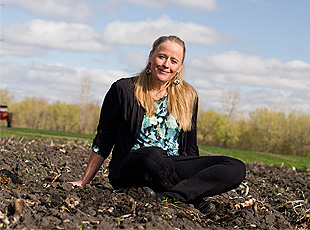How to succeed in the wholesale market
Family Farmed consultant Atina Diffley recently presented several workshops on how to sell crops in the wholesale markets for small-scale producers. “With the Food Safety Modernization Act on the horizon, traceability is key. If you didn’t record it, it didn’t happen”, she said.
 The biggest barriers for small and mid-sized farmers in wholesale markets are food quality and food safety, a farming expert says.
The biggest barriers for small and mid-sized farmers in wholesale markets are food quality and food safety, a farming expert says.
Atina Diffley, a consultant with the Chicago nonprofit Family Farmed, recently presented several workshops based on the curriculum she helped develop for the manual, “Wholesale Success: A Farmer’s Guide to Food Safety, Selling, Post Harvest Handling and Packing Produce.”
“We need to show wholesale buyers that we can produce food that lasts and food that’s safe,” she said. The 30 participants, mostly small farmers and leaders of community food systems, received a copy of the manual.
The same workshop, coordinated by Ecotrust with a USDA grant, was also presented in Hood River, Philomath and Central Point, Ore.
“Fresh produce is alive,” Diffley, who operated an organic farm with her husband in Minnesota for 30 years, said. “When you pick it, you want to slow down the respirations. Temperature management is a way to extend the shelf life of produce.”
The higher the produce temperature, the higher the respiration rate and the quicker it deteriorates, she said. High respiration crops include asparagus, spinach and parsley. Low respiration crops include apples, onions and potatoes.
Maintain the cold chain during harvest, cleaning, cooling, storage and transport.
“Pick it cool, keep it cool, put it to sleep,” Diffley advised. For example, she said, at 7 a.m. when the temperature is 58 degrees, the core temperature of broccoli is about 45 degrees.
“Immediately removing field heat is the single most important step in extending shelf life,” she said. Cool produce to the core and check it with a thermometer.
How produce is handled is also important, she said.
“The less you can handle produce the better,” she said, advising the use of cotton knit gloves, keeping the produce as clean as possible in the field and trimming it immediately at harvest.
Efficiency is also important, she said.
“Where can you increase and improve your efficiency?” This was a question she stressed throughout the day. “Since you will be competing with larger farms and businesses, always ask where and how you can improve your processes. Our challenge is scaling up.”
Sanitation, water safety and water temperature were covered in detail. She recommended hydrogen peroxide-based sanitizers, specifically Tsunami and SaniDate, because rinsing is not required and neither is Ph testing, they are organically allowed and environmentally safe.
Regarding food safety and postharvest handling, Diffley focused on developing processes and systems. Since food poisoning affects 1 in 6 Americans a year and since the individual farmer is liable, it’s crucial to put together a food safety manual that includes maps, farm design, record keeping, policies, training and standard procedures, such as rules for hand washing and first aid.
“Every farm has fecal matter on it, so take that as a given,” she said. Get in the habit of keeping good records. A quick way to document events is to use a white board and take a photo of it at the end of the day.
With the Food Safety Modernization Act on the horizon, traceability is key, she said.
“If you didn’t record it, it didn’t happen,” she said.
On the marketing side, she advised farmers that relationships are the most important thing.
“It’s not about being right, it’s about staying in a relationship. Pay attention to what your buyer values,” she said.
For some, it’s organically grown produce. For restaurants, it’s on-time delivery. For retail stores, it’s quality, volume, consistency and reliability.
She also recommended researching the buyer and meeting with them during the off-season to find out what they want and need. Plan before you plant, she said.
Source: capitalpress.com


